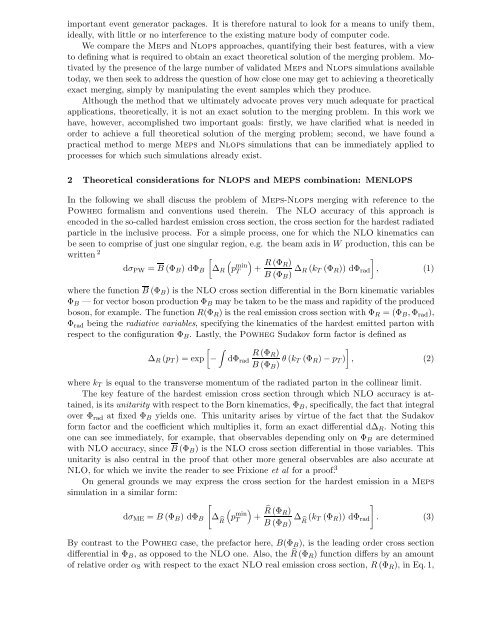2011 QCD and High Energy Interactions - Rencontres de Moriond ...
2011 QCD and High Energy Interactions - Rencontres de Moriond ...
2011 QCD and High Energy Interactions - Rencontres de Moriond ...
Create successful ePaper yourself
Turn your PDF publications into a flip-book with our unique Google optimized e-Paper software.
important event generator packages. It is therefore natural to look for a means to unify them,<br />
i<strong>de</strong>ally, with little or no interference to the existing mature body of computer co<strong>de</strong>.<br />
We compare the Meps <strong>and</strong> Nlops approaches, quantifying their best features, with a view<br />
to <strong>de</strong>fining what is required to obtain an exact theoretical solution of the merging problem. Motivated<br />
by the presence of the large number of validated Meps <strong>and</strong> Nlops simulations available<br />
today, we then seek to address the question of how close one may get to achieving a theoretically<br />
exact merging, simply by manipulating the event samples which they produce.<br />
Although the method that we ultimately advocate proves very much a<strong>de</strong>quate for practical<br />
applications, theoretically, it is not an exact solution to the merging problem. In this work we<br />
have, however, accomplished two important goals: firstly, we have clarified what is nee<strong>de</strong>d in<br />
or<strong>de</strong>r to achieve a full theoretical solution of the merging problem; second, we have found a<br />
practical method to merge Meps <strong>and</strong> Nlops simulations that can be immediately applied to<br />
processes for which such simulations already exist.<br />
2 Theoretical consi<strong>de</strong>rations for NLOPS <strong>and</strong> MEPS combination: MENLOPS<br />
In the following we shall discuss the problem of Meps-Nlops merging with reference to the<br />
Powheg formalism <strong>and</strong> conventions used therein. The NLO accuracy of this approach is<br />
enco<strong>de</strong>d in the so-called har<strong>de</strong>st emission cross section, the cross section for the har<strong>de</strong>st radiated<br />
particle in the inclusive process. For a simple process, one for which the NLO kinematics can<br />
be seen to comprise of just one singular region, e.g. the beam axis in W production, this can be<br />
written 2<br />
<br />
dσPW = B (ΦB) dΦB ∆R p min<br />
<br />
T<br />
+ R(ΦR)<br />
B (ΦB) ∆R<br />
<br />
(kT (ΦR)) dΦrad , (1)<br />
where the function B (ΦB) is the NLO cross section differential in the Born kinematic variables<br />
ΦB — for vector boson production ΦB may be taken to be the mass <strong>and</strong> rapidity of the produced<br />
boson, for example. The function R(ΦR) is the real emission cross section with ΦR = (ΦB,Φrad),<br />
Φrad being the radiative variables, specifying the kinematics of the har<strong>de</strong>st emitted parton with<br />
respect to the configuration ΦB. Lastly, the Powheg Sudakov form factor is <strong>de</strong>fined as<br />
<br />
∆R (pT) = exp −<br />
dΦrad<br />
R (ΦR)<br />
B (ΦB) θ (kT<br />
<br />
(ΦR) − pT) , (2)<br />
where kT is equal to the transverse momentum of the radiated parton in the collinear limit.<br />
The key feature of the har<strong>de</strong>st emission cross section through which NLO accuracy is attained,<br />
is its unitarity with respect to the Born kinematics, ΦB, specifically, the fact that integral<br />
over Φrad at fixed ΦB yields one. This unitarity arises by virtue of the fact that the Sudakov<br />
form factor <strong>and</strong> the coefficient which multiplies it, form an exact differential d∆R. Noting this<br />
one can see immediately, for example, that observables <strong>de</strong>pending only on ΦB are <strong>de</strong>termined<br />
with NLO accuracy, since B (ΦB) is the NLO cross section differential in those variables. This<br />
unitarity is also central in the proof that other more general observables are also accurate at<br />
NLO, for which we invite the rea<strong>de</strong>r to see Frixione et al for a proof. 3<br />
On general grounds we may express the cross section for the har<strong>de</strong>st emission in a Meps<br />
simulation in a similar form:<br />
dσME = B (ΦB) dΦB<br />
<br />
∆ R<br />
<br />
p min<br />
T<br />
<br />
+ R (ΦR)<br />
B (ΦB) ∆R (kT<br />
<br />
(ΦR)) dΦrad . (3)<br />
By contrast to the Powheg case, the prefactor here, B(ΦB), is the leading or<strong>de</strong>r cross section<br />
differential in ΦB, as opposed to the NLO one. Also, the R (ΦR) function differs by an amount<br />
of relative or<strong>de</strong>r αS with respect to the exact NLO real emission cross section, R (ΦR), in Eq.1,








![List of participants 27/2/09 [pdf] - Rencontres de Moriond - IN2P3](https://img.yumpu.com/17975746/1/190x135/list-of-participants-27-2-09-pdf-rencontres-de-moriond-in2p3.jpg?quality=85)







